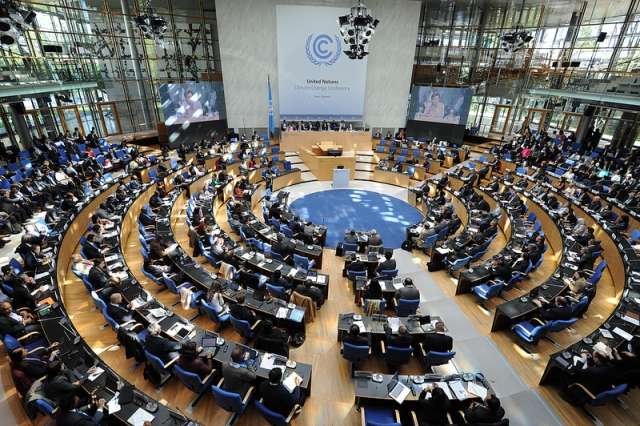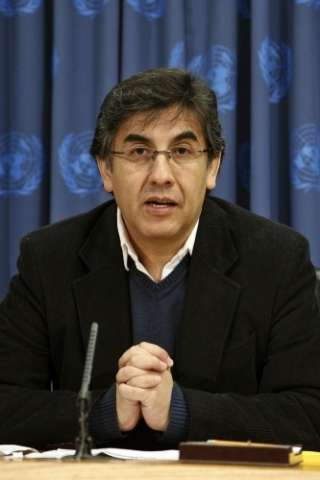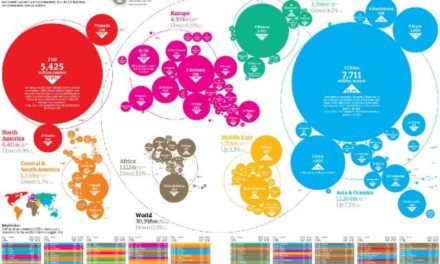by Pablo Solon
The United Nations climate negotiations in Bonn are more of the same and we are running out of time.
Everybody recognizes that there is a “gap”, but there are no concrete proposals to solve the “gap”. Most delegations prefer not to put a number on the “gap” to avoid the embarrassment of what all countries had agreed to in Doha last December 2012.
According to UNEP reports, global emissions should be around 44 GT of CO2e by 2020 to be on track to a 2ºC scenario, that still in fact is dangerous. With the Doha, Durban and Cancun outcomes they will hit the level of 57 GT of CO2e by 2020. So the “gap” is 13 GT of CO2e.
If this “gap” is not closed by 2020 the global average temperature of the planet will increase in more than 4 to 8ºC. The last time the Earth lived a global warming like this was millions of years ago.
In the UNFCCC every delegation knows the urgency of the climate crisis… but the speeches and arguments are almost the same.
The US and others that have quit from the Kyoto Protocol want a “pledge and review regime”. In other words: no targets. No binding commitments. Lets do what each one can do… and lets see. And what is the US willing to do? 3% emissions cut based on 1990 levels by 2020.
This is almost nothing. And what is even worse is that more and more countries are entering into that same dynamic with the argument that even if their countries cut their emissions by half the impact in the global emissions will be less than 1% because the bigger emitters are not taking the lead.
The discussions instead of focusing on how to reduce global emissions to much more less than 44 GT CO2e by 2020 has been about the principles of the Convention, “equity”, “historical responsibility” and “CBDR” (Common But Differentiated Responsibility) between developed and developing countries.
The climate emergency that we are living was not the first priority.
Common sense
First, define the target: global emissions of much more less than 44 GT of CO2e by 2020.
Second, divide that amount between the world population in 2020 (around 7.6 billion). That is 5.7 tons of CO2e per capita by 2020.
Third, apply the principles of the convention (historical responsibility, CBDR and equity) to that per capita number. This will give different targets of per capita emissions for each country.
Those who carry more historical responsibility will have to do more and those with less historical responsibility will have more space for development, but all together will guarantee that the world is below 44 GT of CO2e by 2020.
There should not be a pledge and review system for anybody. No one is exempt. Everybody has to adopt binding commitments. Some do much more, some do less, some can increase emission for some years but its clear when they will reduce and by how much.
And in order to guarantee these binding commitments we need to strengthen the compliance system with some kind of climate justice tribunal and sanctions.
Here the Common But Differentiated Responsibility (CBDR) principle should also be applied. Strong sanctions for historical emitters, moderate sanctions for others and very light sanctions for the least responsible.
In other words the principles of the convention have to be preserved but not understood as if only one side has binding commitments and the other side can do what they want. At this stage of the climate crisis we all have to commit with figures on the table to be below the 44 GT of CO2e by 2020.
Carbon ‘omissions’
Another important issue is the outsourcing of emissions of developed countries.
One third of China’s emissions are consumed in the “developed” world. To be fair and equitable the per capita emissions should take into account the consumption and not only production of green house gas emissions, because many developed countries can simply outsource their emissions.
In the same line a country should not pass its binding commitment to another country through offsets and carbon market mechanisms. The obligation of that country is the obligation of that country.
Finally the issue of the “right to development” should be not understood as the “right to pollute” as much as the others. In Bonn we have heard from many developing countries that they need development to reduce poverty.
This formula is not totally true. In the majority of countries, poverty is the result of concentration of wealth in very few hands. The main task to address poverty is not development but redistribution of wealth at national, regional and global level.
The “right to development” is the right to attend to the fundamental needs of the population following a very different kind of development than the current capitalist way that doesn’t take into account the limits of the Earth.
Pablo Solon is Executive Director of Focus on the Global South, and a former ambassador of the Plurinational State of Bolivia to theUnited Nations. Photo from UNFCCC Flickr









